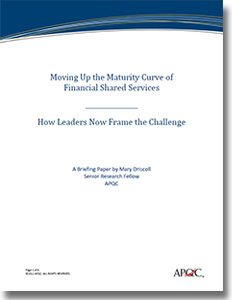Moving Up the Maturity Curve of Financial Shared Services
Large, global organizations have, over the past decade, made clear strides in reducing the cost of financial management operations by adopting a shared services operating model.
How can you tell if a financial shared services organization is well on its way up the maturity curve?
For a start, the leadership team looks beyond cost reduction.
Surely, there is a constant hunt for cost-efficiency, but there is also talk of process innovation and value-adding capabilities.
A good example is Citigroup. Arindam Mukhopadhyay, the executive vice president who manages global financial reporting operations for the sprawling financial institution, summed up this view in a speech he gave at a conference on Finance Transformation, produced by the Shared Services Outsourcing Network (SSON) last September.
“Finance is not a department of accountants and analysts but a series of processes that culminates in stewardship and decision making. For this reason, building a shared services model cannot be a cost-only play.”
His view is shared by other global players working to ensure their respective shared services units can achieve productivity gains every year and develop increasingly mature capabilities.
The leaders view process innovation as a never-ending quest, with no anticipated end to productivity gains or expectation of diminishing returns.
“My incentive compensation is tied to a 5 percent productivity increase, every year, in perpetuity. And I’m quite happy with that,” said a senior finance executive who runs a top-notch global business services group in an interview with APQC.
In all, the executives who manage these ever-evolving shared services centers say their roles are becoming more strategic. They aim to:
- generate and disseminate financial intelligence across their organizations in order to drive strong decisions concerning the allocation of capital,
- continuously pursue opportunities to reduce the cost of core transaction processing, and
- improve internal controls and rules compliance in an era of regulation.
What’s Related


Favorites





